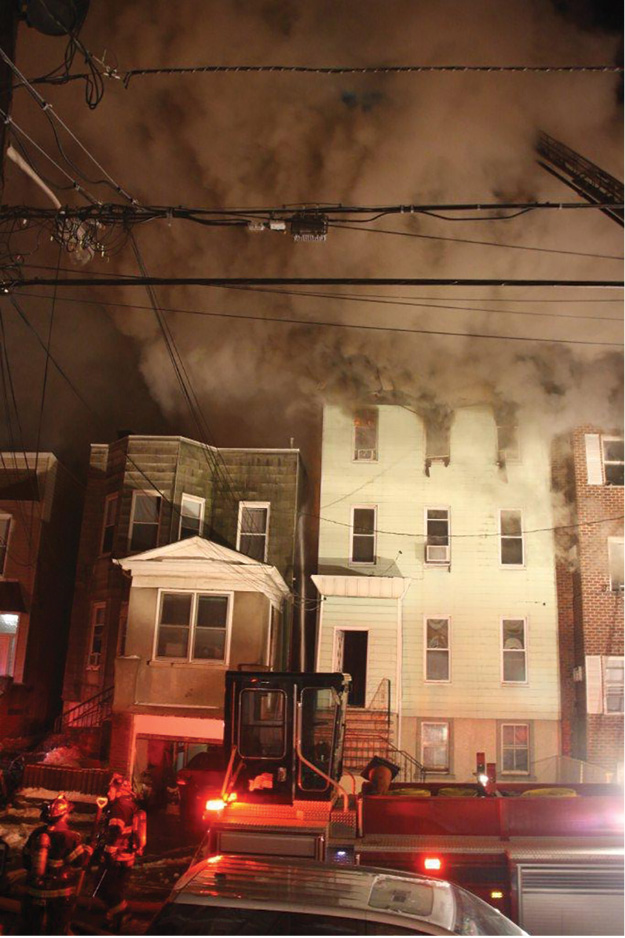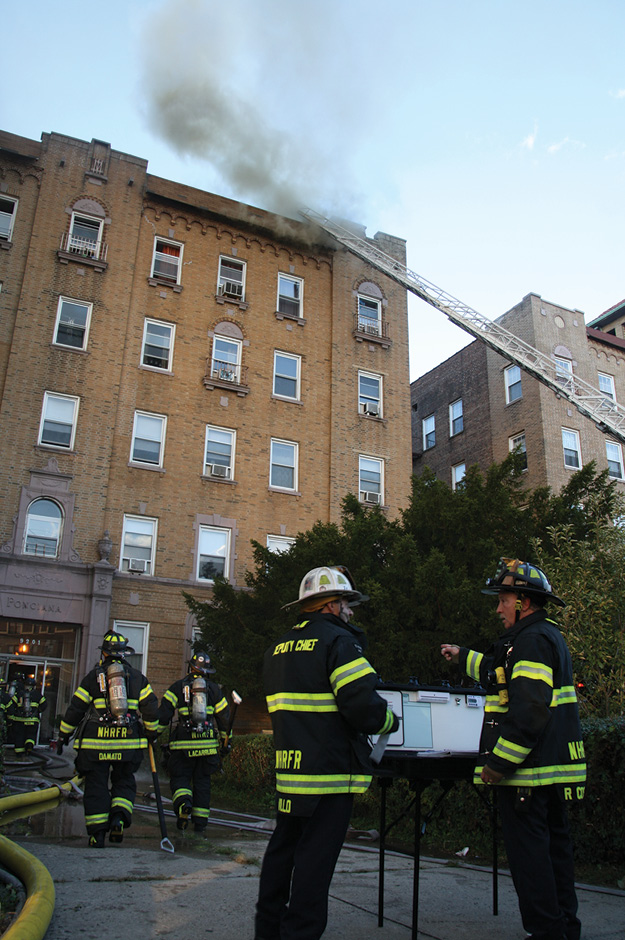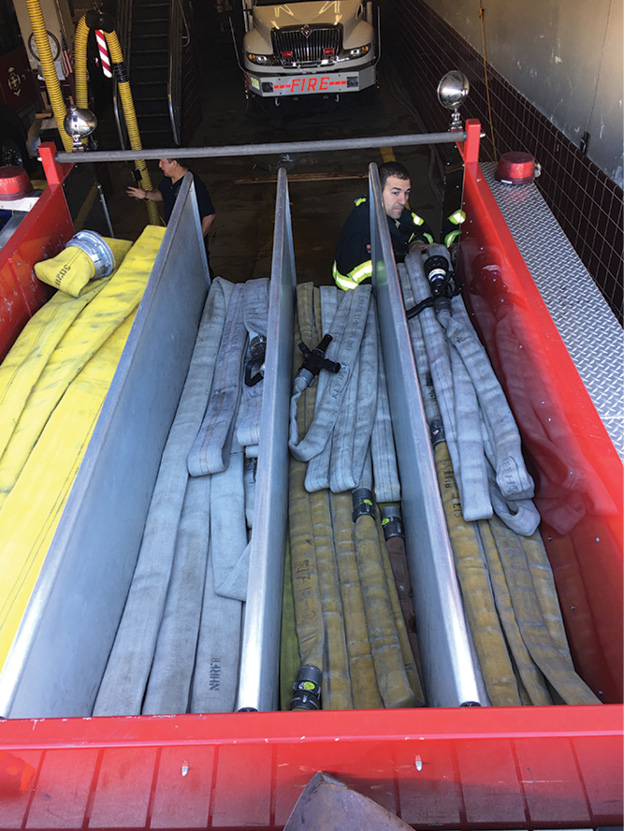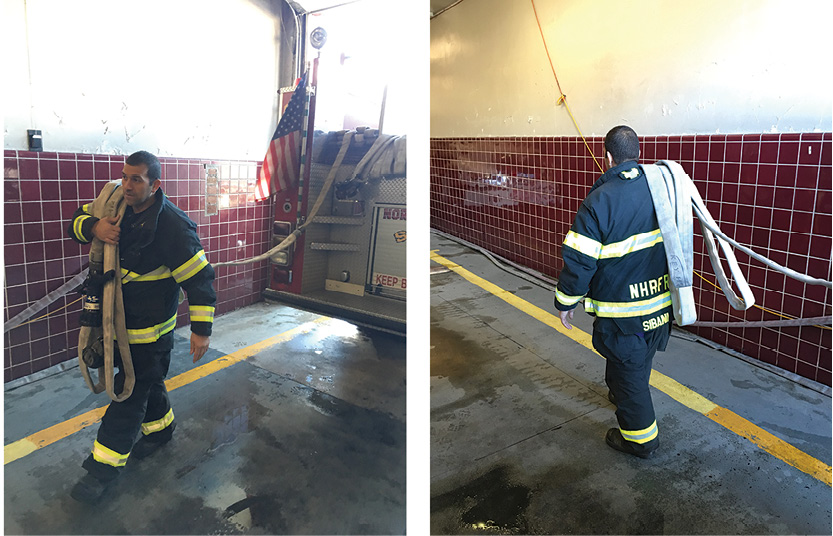
By Anthony Avillo
Applying water to a fire has never made the fire worse, and there is nothing more important than the stretching of the initial hoseline. Many departments operate with three-firefighter engine companies. If one firefighter is assigned to the pump, that leaves two firefighters to stretch the line. This is totally inadequate for a stretch to the ground floor but is even more problematic (and nearly impossible) for a stretch to an upper floor. How can we be successful with this limited staffing (photos 1-2)?

(1) How can we possibly use a two-person stretch to get water on these two fires? They must be “all-hands” stretches in which as many personnel as are available are enlisted to get the first line in service and operating on the fire. (Photos by Ron Jeffers.)
Department standard operating procedures (SOPs) should mandate, stress, and enforce how crucial it is to get this first line (first water) on the fire. If staffing is short, merging two or even three engine companies to get the first line in place is not only warranted but mandatory. If the policy or “normal procedure” calls for every engine to stretch its own line, it is likely that when there is a challenging stretch, none of the lines will get there. Instead, you will wind up with an impossible, entangled bundle of spaghetti (and firefighters) just inside the entrance to the building. This tactical breakdown will jeopardize stairwell and egress integrity, trapped (and even not so trapped) victims, searching personnel, and the companies stretching additional handlines to other areas of the building. If the first line does not get to the right place and put water on the fire, all the other well-intentioned lines and support tactics are not going to matter.

(2) How can we possibly use a two-person stretch to get water on these two fires? They must be “all-hands” stretches in which as many personnel as are available are enlisted to get the first line in service and operating on the fire. (Photos by Ron Jeffers.)
In North Hudson (NJ) Regional Fire and Rescue (NHRFR), the initial scene assignment SOP mandates that the first two engines work together to get the first line and the water supply in service. This is crucial when you must stretch to upper floors or even deep into a building that has been renovated, loaded with items, or both. In fact, if the fire is on or above the third floor, the NHRFR will use the first three engines to get the line in service. Once the line is in place and operating, the incident commander has the option of redeploying the third engine for another duty [usually to help the fourth-due engine with the second line (backup)].
People in the Right Positions

(3) When the line being dragged is longer than the firefighter is tall, it will snag on everything in its way. This is an extremely inefficient way to stretch a line.
The policy of stretching efficiently should place the right people in the right places so that the line moves toward the objective as quickly as possible. Everyone can’t be near the nozzle! Stagger personnel along the stretch so that the line gets to where it needs to be with minimal kinking and without snagging on car tires and bannisters or other stretch-unfriendly areas. To accomplish this, someone should ideally be in place at every turn, which is not always easy with short staffing. Again, mating companies is the answer.

(4) The static hosebed with two attack lines on the right set up with a nozzleman shoulder load (NSL) on top.
One member should be with the nozzle and first length. Another member should be close behind but not on top of the first member. People should be on the stairs/landings to “bus wheel the stretch” like a conveyer belt. The term “bus wheel” means that each firefighter in the stretch moves the line from hand to hand as it makes its way up the stairs. All firefighters in the stretch, except those at the nozzle, stay relatively stationary until the line gets to the drop point. It should be like a worm—segments of hose moving from the back toward the front. The line must move from outside in; if the back of the line does not move, the front can’t move.
An important place along the stretch is at the entrance door where a “door” firefighter communicates with the chauffeur as to when to “break the line” and to ensure the line is running smoothly through the door. This person can be a second-due officer. The first-due officer should be with the nozzle firefighter. All other strategically positioned firefighters along the stretch route should be “bus wheeling” the line to ensure enough is available to reach the objective.
Whoever has the nozzle should arrive at the drop point with at least a length of hose (50 feet). If all this firefighter has is the nozzle, he is going nowhere.

(5-6) The NSL on the nozzleman’s shoulder, front view and back view. This bundle must make it to the drop point closest to the fire.
First-Length Problems
One problem can occur when the nozzle firefighter begins the stretch. No matter how the hose is bundled or preconnected, it is inevitably longer than the firefighter is tall. A hosebed can be about 15 feet deep, and preconnects can be about eight feet long. This always leaves hose dragging behind (on the ground) and into the building. This is what I call “snag central.” That first length will catch everything it passes, especially on a turn. This creates major snags and often results in the firefighter’s dropping the bundle at the bottom of the stairs and just carrying the nozzle up the stairs, causing the advance to be stopped by the spaghetti on the ground floor and in the stairs.
The problem is compounded when firefighters who want to get in on the action bypass this mess and move up the stairs toward the nozzle firefighter, making the situation worse: Everyone is at the top pulling on an impossibly snagged line while the fire gets bigger.
Stretching to the Upper Floors
After a multiple-alarm fire on the top floor of a four-story apartment building where the inability to properly stretch lines caused the loss of the top floor, it was apparent that there was a need to revisit the way lines are stretched, especially to upper floors of multiple dwellings. In addition to reinforcing the “all-hands” concept of stretching, one of the companies began experimenting with what was termed a “nozzleman shoulder load” (NSL). This is similar to a high-rise bundle without the straps. It is one 50-foot length folded no longer than six feet and carried over the nozzle firefighter’s shoulder with three feet hanging in the front and three feet hanging in the back. It easily makes turns and avoids snags and obstructions. Couple this with additional firefighters (from other companies) strategically placed along the stretch to methodically bus wheel the line in place like a conveyor belt. Once the NHRFR worked with this for a while, we could see how quickly and efficiently the line got to the upper floors and water got on the fire.
One last point: Don’t permit the nozzle firefighter to just “grab the nozzle and go.” This is a surefire way to mess up a stretch. Just grabbing the nozzle can almost guarantee that the first length of hose will snag on whatever is in its path. And, as mentioned, once the nozzle-only firefighter gets in position to fight the fire, how can the line be advanced if all of it is behind on the stairs below? The NSL gets the first length right to the drop point. Try it!
Anthony Avillo retired in 2015 after a 30-year career in the fire service. He was a deputy chief in North Hudson (NJ) Regional Fire and Rescue. He has a B.S. degree in fire science and a master’s degree in national security studies from New Jersey City University. Avillo is the director and deputy fire marshal at the Monmouth County (NJ) Fire Academy. He is also an adjunct professor at New Jersey City University, teaching fire science. He is a member of the FDIC International advisory board and the editorial advisory board of Fire Engineering. He is the author of Fireground Strategies, 3rd edition (Fire Engineering, 2015) and Fireground Strategies Workbooks (Fire Engineering, 2002, 2010, 2016) and co-author of Full Contact Leadership with Ed Flood (2017). Avillo has contributed to both volumes of the Pass It On books by Billy Goldfeder (Fire Engineering, 2015, 2016) and the Tactical Perspectives DVD series (Fire Engineering, 2011). He issued the DVD Control of Fireground Operations and Forging a Culture of Safety (Fire Engineering, 2016, 2014). He was the recipient of the 2012 Fire Engineering/ISFSI George D. Post Fire Instructor of the Year Award.

